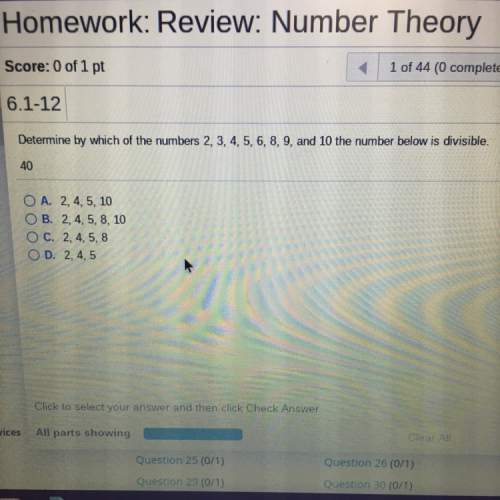
Mathematics, 17.04.2020 20:31 delawdermia27
Walter’s history test scores and Janine’s history test scores are shown on the dot plots below.
Walter’s History Test Scores
A dot plot tilted Walter's History Test Scores. A number line going from 80 to 90. There are 0 dots above 80, 81, and 82, 1 above 83, 2 above 84, 2 above 85, 2 above 86, 2 above 87, 0 above 88 and 89, and 1 above 90.
Janine’s History Test Scores
A dot plot tilted Janine's History Test Scores. A number line going from 80 to 90. There are 0 dots above 80, 81, 82, and 83, 3 above 84, 2 above 85, 2 above 86, 3 above 87, and 0 above 88, 89, and 90.
If each student gets 65 on the next test, which explains the measure of center that would be most affected?
Their means will be most affected because this value will be an outlier.
Their modes will be most affected because the distribution has changed.
Janine’s median will be more affected than Walter’s median because her overall scores were greater.
Walter’s median will be more affected than Janine’s median because there was a gap in his data.
Mark this and return

Answers: 1


Another question on Mathematics

Mathematics, 20.06.2019 18:04
Fran would like to estimate the mean amount of time it takes people in her town to travel to work. the town's population is 150,000 and about 90,000 of those are working adults. which statements are true? select each correct answer. there is no way to infer the value of the mean. she must collect data for all 90,000 working adults and calculate the mean. a larger sample of working adults will provide a better estimate of the true mean than a smaller sample. the population of working adults is too large for using a sample to estimate the mean of the entire group. if she takes a random sample of the population of working adults in her town, the mean for that group is likely close to the mean for the entire group.
Answers: 2

Mathematics, 21.06.2019 19:00
Since opening night, attendance at play a has increased steadily, while attendance at play b first rose and then fell. equations modeling the daily attendance y at each play are shown below, where x is the number of days since opening night. on what day(s) was the attendance the same at both plays? what was the attendance? play a: y = 8x + 191 play b: y = -x^2 + 26x + 126 a. the attendance was never the same at both plays. b. the attendance was the same on day 5. the attendance was 231 at both plays on that day. c. the attendance was the same on day 13. the attendance was 295 at both plays on that day. d. the attendance was the same on days 5 and 13. the attendance at both plays on those days was 231 and 295 respectively.
Answers: 1

Mathematics, 21.06.2019 19:00
John used linear combination to solve the system of equations shown. he did so by multiplying the first equation by -3 and the second equation by another number to eliminate the x-terms. what number did jonas multiply the second equation by? 4x-6y=23x+5y=11
Answers: 2

Mathematics, 22.06.2019 01:00
Given the net of the rectangular prism, what is its surface area?
Answers: 1
You know the right answer?
Walter’s history test scores and Janine’s history test scores are shown on the dot plots below.
Questions





Computers and Technology, 21.01.2021 23:00


Mathematics, 21.01.2021 23:00

Mathematics, 21.01.2021 23:00

Mathematics, 21.01.2021 23:00

Mathematics, 21.01.2021 23:00


Chemistry, 21.01.2021 23:00

Mathematics, 21.01.2021 23:00




Biology, 21.01.2021 23:00

Mathematics, 21.01.2021 23:00


Mathematics, 21.01.2021 23:00




